Radon - precautionary measures for new buildings Properties, occurrence and effect of radon
Properties and occurrence
Radon is a naturally occurring radioactive noble gas that is colorless, odorless and tasteless. It is a decay product of the radioactive heavy metal uranium found in soils and rocks. Radon escapes from soils and rocks into the soil air. With the soil air, it can enter the indoor air of buildings.
An initial indication of whether elevated radon concentrations can be expected in the indoor air of buildings can be obtained from the national radon maps. Only a measurement can give certainty about the radon concentration in the respective building.
Detailed information on radon can be found on the country-specific websites. These addresses are listed on the back of this brochure.
Note: National specifications or recommendations may differ from the present contents!
Annual mean radon concentrations normally range from 50 to 500 becquerels per cubic meter of air. However, values up to several 1,000 Bq/m³ can also be reached - especially in radon areas.

Effect on health
After smoking (about 85%), radon and its decay products are a leading cause (5 to 10%) of lung cancer. In people who have never smoked, radon is the most common cause of this type of cancer. Radon and smoking reinforce each other in their harmful effects on human health. Most of the radon inhaled through the air is exhaled again. The greatest health risk is therefore not posed by the radioactive noble gas radon itself, but by its short-lived decay products (radioactive heavy metals).
The free decay products present in the indoor air attach themselves to airborne suspended particles (aerosols). When breathing, the aerosols with the attached radon decay products are deposited in the lungs. From there, they emit ionizing radiation that can damage the immediately surrounding lung tissue and ultimately cause lung cancer.
Reference values and threshold values
The following table shows the current reference values and thresholds for annual mean radon concentrations in homes or workplaces of the different countries.
| Country/Region | Reference values for existing buildings | Reference values for new buildings | Threshold values |
| Germany | 300 Bq/m3 | 300 Bq/m3 | - |
| Austria | 300 Bq/m3 | 300 Bq/m3 | - |
| Switzerland | 300 Bq/m3 | 300 Bq/m3 | *1,000 Bq/m3 |
| South Tyrol | 300 Bq/m3 | **200 Bq/m3 | - |
* for workplaces
** for living quarters as of 31.12.2024

Composition of the subsoil
In addition to the composition of soil and rock (uranium, radium content), the grain size of the rock (release of radon to the soil air) and the permeability of the subsoil (onward transport of the radon-containing soil air) play an important role. Special caution is required for rubble cones and slopes, weathered granite, karst and gravel soils (high radon availability due to good permeability) - in contrast to very compact or clayey soils.

Building condition
The permeability of a building to soil air in the foundation area as well as in walls in contact with the ground is decisive. Possibilities of penetration exist, for example, through cracks and crevices as well as along cable and pipe penetrations. The radon-containing soil air is sucked into the building by a negative pressure created in the building (chimney effect due to temperature differences between room and outside air or due to wind pressure). If cellars or other building areas with ground contact are open to floors above, radon can spread upwards particularly easily.

Air exchange in the building
The exchange between indoor air and outdoor air has a significant influence on the level of radon concentration indoors. Leaky windows and doors lead to higher air exchange rates. If, on the other hand, the air exchange rate is reduced, for example by installing tightly closing windows and doors, the radon concentration in indoor spaces can increase considerably.
Structural precautionary measures
Preventive measures are much simpler, more effective and, in the long term, cheaper than subsequent radon remediation.
Basically, the tighter the building envelope is against the ground, the lower the radon risk.
Radon precautionary measures should be planned in cooperation with radon specialists, building experts or engineering companies.
Basic measures
It is important to comply with the existing legal provisions for moisture protection. Structures with living quarters and/or workplaces, as well as other structures whose intended use requires it, must be permanently protected in all their parts against the penetration of water and moisture from the ground. Special attention must be paid to a tight feed-through of the lines (pipes, cables) through the components in contact with the ground.
Ground probes for heat pumps represent a potential radon entry path due to their depth. Care must always be taken to ensure that the lines (pipes, cables) pass tightly through the components in contact with the ground - for example, by using a pipe penetration system (annular space seals, lining pipes, wall collars, etc.).

In the case of geothermal heat exchangers, air wells and similar systems, it must be ensured that no soil air containing radon enters the building via the ventilation system.
Air-earth heat exchangers must therefore be designed with airtight pipes (plastic) with tight joints. An alternative to the airtight design would be to operate the ground register in positive pressure.
For air wells, the gravel filling must be limited laterally and downwards by an impermeable layer (impermeable soil, for example clay or foil (thickness ≥ 0.5 mm)). Suitable precautions must be taken for the discharge of water from the air well (for example pumping out, siphon). A control measurement to check the annual mean radon concentration in the building is recommended in this case.
Translated with www.DeepL.com/Translator (free version)

Links: falsche Ausführung; Rechts: richtige Ausführung
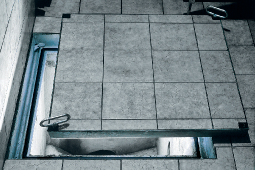
Links: falsche Ausführung; Rechts: richtige Ausführung
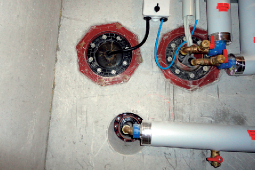

Simple measures
Type I:
Your house has a full basement (basement, ventilated crawl space) and has no living/working spaces in contact with the ground.
Waterproofing measures between the basement area and occupied parts of the building must be provided, for example:
- self-closing, airtight cellar door to the living area
- professional sealing of penetrations (for example, pipes for water, electricity, heating) through the basement ceiling
- sealing of installation ducts, elevator shafts and drop shafts (for example for laundry)
- Cellar rooms with natural flooring should be specially sealed to the inside and preferably only accessible from the outside
Inlets and outlets through building components in contact with the ground for electricity, water, sewage, etc. should be sealed (for example, by means of feed-through systems for pipes and cables).
Type II:
Your house does not have a full basement and has living/working spaces with ground contact.
The following must be observed:
- Use continuous floor slab and walls with ground contact made of concrete of exposure class XC1 or higher. Alternatively, an underfloor extraction system can be installed (see page 9 under "Extensive measures").
- Inlets and outlets through components with ground contact for electricity, water, wastewater, etc. must be tightly sealed (for example, by means of feed-through systems for pipes and cables).
Extensive measures
Underfloor extraction (radon drainage)
This measure is primarily used to create a negative pressure underneath the floor slab opposite the building. This reduces convective radon ingress from the soil. Inlets and outlets through building components in contact with the ground for electricity, water, wastewater, etc. must be tightly sealed (for example, by means of feed-through systems for pipes and cables).
Drainage pipes with a diameter of at least 8 cm are to be laid under the continuous foundation slab or the floor slab (in the case of strip foundations). The method of pipe laying depends on the permeability of the surrounding material. If gravel or crushed stone is installed, the pipe system is laid in a serpentine form with a pipe spacing of up to 8 m and joined together to form an exhaust pipe (solid wall pipe).
If the pipe system is installed directly into the ground (pipe protection by gravel and/or fleece), a smaller distance of 1 to 3 m is required. A minimum distance of 1 to 2 m must be maintained from the outer walls. In order for a negative pressure to be built up in the radon drainage system, an inflow of air from the water drainage system must be prevented (separation of the systems, for example, by foundation or foil).
Note on subsoil suction in highly permeable soils: In the case of gravel soils and highly fissured soils (e.g. karst areas), no negative pressure can be built up under the floor slab without additional measures. Under the radon drainage system, therefore, the permeability to the soil must be greatly reduced with lean concrete or a foil.

Left: Installation in crushed stone and gravel bed (pipe spacing up to 8 m); Center: Lean concrete in highly permeable soils; Right: Installation in soil (pipe spacing 1 to 3 m).
Design variants for the exhaust duct of the radon drainage:
- Recommended: Run solid-wall pipe with a diameter of at least 12.5 cm above the roof (for example, in the installation shaft). In this design, negative pressure generation is exploited due to the chimney effect in the riser pipe (thermal insulation of the riser pipe in the cold attic is required). Advantages: passive negative pressure generation, no operating costs for fan.
- Optional: In preparation for active negative pressure generation with fan, a solid wall pipe of at least 10 cm diameter is led through the floor slab, sealed airtight and marked as a radon exhaust pipe.
If the control measurement shows an increased radon concentration, a fan for active negative pressure generation must be used for both design variants. It is essential to take into account the formation of condensation in the pipe system and the noise generated by the fan. The air outlet should be located at least 2 m away from windows and doors.
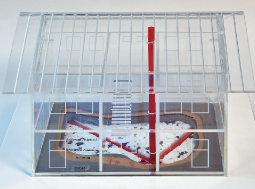
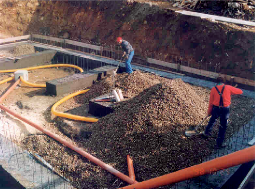
The ventilation system should - if technically possible or if there are no objections based on building physics - be operated pressure-neutral or with a slight overpressure (a few pascals).
The fresh air intake outdoors should be placed at least 1.5 m above the ground (for example, no intake from basement window shafts, as the radon concentration is higher near the ground).
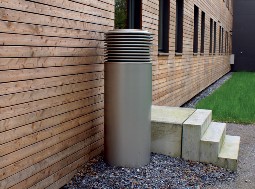
Facts and advice
- Radon is the second leading cause of lung cancer after smoking.
- Radon enters buildings from the ground through leaks.
- National radon maps are a first source of information.
- Only a measurement can give certainty about the radon concentration in the respective building.
- A tight building envelope to the ground lowers radon penetration.
- A simple radon drainage system protects in the risk area.
Radon information
Brochures of this series (not barrier-free):
- Radon - Measurement and assessment
- Radon - precautionary measures for new buildings
- Radon - remediation measures in existing buildings
- Radon - Influence of energetic (thermal) refurbishment
On the Internet:
AGES - Austrian Agency for Health and Food Safety - Austrian Radon Center
Wieningerstrasse 8 A-4020 Linz
Phone: +43-50-555-41902
E-mail: radonfachstelle@ages.at
Internet: www.ages.at
Office of the Upper Austrian Provincial Government Department of Environmental Protection/Radiation Protection
Kärntnerstrasse 10-12 A-4021 Linz
Tel.: +43-732-7720-14543
E-mail: radon.us.post@ooe.gv.at
Internet: www.land-oberoesterreich.gv.at
Bavarian State Office for the Environment Radon-Fachstelle Bayern
Bürgermeister-Ulrich-Strasse 160 D-86179 Augsburg
Tel.: +49-821-9071-0
E-mail: radon-fachstelle@lfu.bayern.de
Internet: www.lfu.bayern.de
Federal Office of Public Health Radiological Risks Section
Schwarzenburgstrasse 157 CH-3003 Bern
Tel.: +41-58-464-68 80
E-mail: radon@bag.admin.ch
Internet: www.ch-radon.ch
National Agency for Environment and Climate Protection Laboratory for Air Analysis and Radiation Protection
Amba Alagistraße 5 I-39100 Bolzano
Tel.: +39-0471-417140
E-mail: luca.verdi@provinz.bz.it
Internet: https://umwelt.provinz.bz.it/strahlung.asp
Ministry of Environment, Climate and Energy Baden-Württemberg